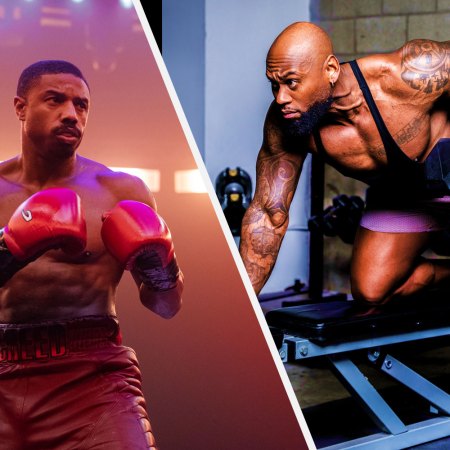Lifters are scary at the gym.
Not big-scary, necessarily, though many of them are. They’re self-assured-scary. Regular lifters walk around their health clubs with all the comfort and confidence of a homeowner in their living room. They take mirror selfies, then take their shoes off. They do a shimmy when a song comes on that they really like. They spray things down when they’re done using them and always know exactly where to put them back.
Theirs is an intimidating world, and one — even if you’re inclined to join it — that sometimes feels best avoided. It’s easier to use the spin bike in the corner for 30 minutes, and maybe cap it with a few rounds of push-ups, than to experiment with varying forms of rows, presses and deadlifts, which you conclude will leave you looking weak and/or silly.
But this line of thinking fuels the misconceptions that A) all “lifters” are experts themselves and B) lifting is some sort of complex calling. Neither are true. Some thoughts to consider:
- Strength training (a more accurate and inclusive phrase that I’ll use from here on out) isn’t nearly as scary as it seems
- Not everyone who strength-trains has Arnold-level aspirations
- In fact, many strength-train as a secondary or even tertiary exercise activity to another concentration (running, rock climbing, basketball, you name it)
- Strength training should not be seen as a lifestyle choice
That last bullet might raise some eyebrows. Why should anyone feel compelled to start lifting?
Because strength training is a longevity play. Studies have linked regular resistance exercise with stronger bones, sharper brains and a reduced risk of weight gain, high blood pressure, heart disease, back pain and arthritis. Despite the activity’s obvious association with bodybuilding, strength training isn’t just a method for big guys to get bigger by next summer. It’s a blueprint for any adult interested in building a better life.
Earlier this year, Arnold Schwarzenegger (now 75 years old) made headlines when he claimed that he would never stop training. “Nothing will ever change until I die,” he said. Is that because he’s entering competitions again? Or hoping to recreate some magic from half a century ago? Of course not. He lifts because it makes him happy and keeps him healthy.
It’s never too late for anyone — no matter your age, size or gender — to start a dedicated strength training regimen. We’ve assembled a low-stakes guide for those who’ve historically felt a little shy around the dumbbell racks. From the key buzzwords to know, to our preferred weekly cadence, to the joy of swinging around medieval weapons, here’s everything you need to know.

Where to even begin
Start light! If you hang around weightlifters long enough, you’ll notice they aren’t all slinging around 80-pound dumbbells. Some — even the biggest in the gym — may make frequent use of the lightest weights available. Why? Because lifting light is an effective strategy; it encourages proper form, allows full range of motion, mitigates risk of injury and allows trainees to “lift to failure.” Recent studies have confirmed that effort, not just load (as in larger weights) can lead to muscle gain. Which is why lifters regularly work “drop sets” into their training; they’ll do an exercise in three different sets, and with each set, will lift a little lighter, while upping the repetitions. The last reps of the last set will be extremely difficult, even if they’re using dumbbells that would feel like toothpicks when they enter the gym fresh.
So. Why should this matter to someone who’s just starting out? Well, rest assured that no one walks around a gym chuckling at anyone training with lighter weights. In fact, it can even be a sign that you know what you’re doing. (Contrast that with the overzealous lifter who uses their low back to swing bicep curls back and forth.) Keep the weights light, focus on form and aim for lots of reps. When you’re just starting out, there’s no need to lift for more than 45 minutes. You can probably keep it to a half-hour or less, honestly. For most moves, aim for two sets at 15 reps apiece. If you’re plugging in bodyweight exercises, which are going to be a bit more difficult at the beginning of a strength training regimen, the rep count will vary at your discretion. Here’s an example of a simple five-move workout:
- Warmup: Five minutes of jogging, jumping rope or getting loose with an AssaultBike
- Bent-over rows: Two sets at 15 reps apiece
- Single-arm dumbbell rows: Two sets at 15 reps apiece, per arm
- Hammer curls: Two sets at 15 reps apiece
- Lat pulldowns: Two sets at 15 reps apiece
- Pull-ups: One set to failure…some trainees like to reserve difficult boydweight exercises (pull-ups, push-ups, parallel dips) for the beginning of their workouts, when they’re still fresh. I like to finish with them, and go until failure, because they really zap your muscles if you’re doing them right.
- Rest: Take a minute or two in between set. Hydrate frequently.
You don’t have to strength-train at a gym, obviously — the pandemic ushered in an era of subscription-based fitness apps, and it’s very possible, with a combination of resistance bands, a few choice weights and a willingness to do bodyweight exercises, to reap the rewards of strength training without ever leaving your house. But the diversity of toys and tools at most gyms is unmatched, and in my opinion, that separation of church and state makes it easier to lock in and attack the task at hand.
As for the apps, their greatest asset is often the fact that they’ll show your “trainer” performing the exercise they want you to do on an endless loop, which is a surefire way to make sure you perform it correctly. And even if you one day tire of the app’s content (or just the action of paying for it), you’ll have years of moves to sample from your own mental library. One app I highly recommend, which helped me bench 235 pounds a couple years back (50 pounds above my weight at the time) is Chris Hemsworth’s Centr service. In the name of building a reliable “bank” of exercises, I’d also recommend booking at least one session with an experience physical trainer and explaining your goals. It’s likely they’ll introduce a move or concept you would’ve otherwise never integrated into your training.
Lifting-related Buzzwords to know
There are a ton, unsurprisingly. Don’t worry about hammering down all the lingo. It’s only important if it’s helping you simplify your training regimen or the way you approach an exercise. Two phrases that I wish I knew at the beginning of my lifting journey are time under tension and mind-muscle connection. The first, often stylized as TUT, refers to maximizing the amount of time a muscle remains under strain during a set. Put simply, weightlifting isn’t a race. If you try to breeze through every set, you’re sort of wasting your time. Make sure each set lasts at least 30 seconds; delaying that granular gratification of being done with a set will result in muscle gain down the line.
Meanwhile, TUT works in tandem with mind-muscle connection, which is a mental strategy that uses “focused attention” to zero in on the muscle contraction, wherever it’s happening in your body. It sounds self-evident, but our brains are pretty good at getting distracted — by the pain, by someone else in the gym, by a work call you have to handle after the workout. In order to remain in the moment, and give each repetition its due, it’s essential that you adopt physical ones (e.g. tightly wrapping your fingers around the bar) and develop mental cues (picturing your muscle contracting). Believe it or not, this sort of focus helps your body get better at expecting and performing under tension. And in the long run, the research bears out, it increases muscle activity.
Push-pull
This is — hands down — my single biggest recommendation in the arena of strength training. Push-pull isn’t a specific workout, but a prescription for how to split one’s lifting during a given week. Half the days should revolve around pushing movements. The other half should focus on pulling movements. The easiest way to wrap your head around this concept is to consider the two poster-boy exercises for each movement: push-ups and pull-ups. When you perform a push-up, you’re pushing against the floor to create strain. When you perform a pull-up, you’re pulling your body towards the bar to create strain. If you’re ever uncertain about whether an exercise qualifies as push or pull, just mime the movement to yourself, and the answer will reveal itself pretty quickly.
Push exercises specifically target the chest, shoulders and triceps. Pull exercises engage the back, biceps and forearms. It isn’t necessarily incorrect to mix and match exercises from either of these “buckets” in one lifting session. But on the flip side, formulating your weekly routine around this central credo is an economical way to get several excellent workouts in each week, and know exactly what you’re looking to accomplish each go-around — dilly-dallying kept to a minimum.
When you train by movements, you’re engaging all the muscles that are most likely to get recruited for those movements. It’s functional fitness — giving you the strength you need to perform intensive tasks you’ll encounter in daily life — and it’s full-body, too, just spread out over the course of a week. On Monday, for instance, you might do a variety of push exercises. On Tuesday, you’ll pull. Wednesday is a rest day, or something entirely different: legs, core, a longer cardio session. But Thursday and Friday, you can get right back to it: push, then pull. Prioritizing movement over muscles helps disperse the focus (and the resulting strain) throughout the body, so no one part is ever carrying too much of the load. Notice that our sample workout above would be a “pull” day. Head here more examples of push and pull moves.
On the dreaded “leg day”
Look, you don’t have to lift your lower half. Introducing any form of strength training to your life is already a big step, and it’s understandable (even as you squash some of your other fears around the gym) if the squat rack remains a bit of a boogeyman. That said: if you do decide to lift your legs, don’t just do it to ward off those “Did you skip leg day?” chirps. That’s a losing game. Literally no one is immune to that tired barb — the likes of Hemsworth and freaking Giannis Antetokounmpo have been subject to ridicule online, thanks to photos where their legs look slightly more ski pole than Christmas ham.
Our stance? Forget the peer pressure and strength-train your lower half for you. Because it’s going to usher in a wave of muscle-building benefits throughout the rest of the body. Lifting legs works the lower abs and the inner thighs, which strengthens the core, bolster stabilization and keeps injuries at bay. Meanwhile, because muscles like the gluteus maximus and the quads are so large to begin with, regularly activating them will help you burn more calories, and catalyze a cascade of hormonal responses throughout the body, which then help other muscle groups grow.
You can definitely keep your lower half fit and reap some full-body benefits by mixing bodyweight exercises (air squats, lunges, animal crawls, etc.) with various anaerobic pursuits (stair-running, hill sprints, high-resistance spin sessions). All will help your legs get stronger. But you should pepper in some leg-day exercises, too. Think: deadlifts, barbell full squats, weighted step-ups, Bulgarian split squats (not as complicated as they sound) and reverse lunges. Keep the weight extremely low on these exercises as you perfect the form; for the barbell squats, I wouldn’t even put anything on the bar to start. In order to ease into the idea of lifting legs, you might also want to experiment with some of the leg machines throughout the gym. Look for the leg press, the hack squat, the leg extension and the calf raise machines to get started.

Unconventional training
There is a customary honeymoon period that most trainees reach after committing to a month or more of regular lifting. This is the point at which markers of progress become evident in the gym, and you can’t imagine ever going back to a life before weighted plates. It’s a good feeling. But it’s a fleeting one. In the same way that some Pelotons turn into $2,000 laundry racks, so too can DIY strength training regimens eventually feel familiar, then rote, then stale. A mental weariness with performing the same moves over and over again often coincides with a physical plateau — as the body gets stronger, it adapts to the activity, which may lessen discomfort but also torpedoes gains and sabtoages inspiration.
There are a few ways to break out of this rut. You can play with the weight, the number of repetitions or level of the intensity for specific moves across your workouts; you can hire a trainer who’s going to make you do the most important exercises in the gym (invariably, the three or four you’re most likely to avoid — I’ll confess, I routinely skip pull-ups); and you can try your newfound strength in a different activity, which may compel you to get back in the lab and start working hard again. For instance, you may find a little more core power propelling your backhand in tennis, or a little more grip strength allowing you to cling to the wall during rock climbing.
But one other method that you should employ is unconventional training, which involves introducing tools like kettlebells, sandbags, truck tires, battle ropes, sledgehammers, and weighted bats into your regimen. Some of these tools (like battle ropes) were invented recently. Others, like the mace, have been around forever. All will force your muscles, tendons, joints and ligaments all to work a bit harder than usual, to account for how goddamn unstable the equipment is. The weight distribution either shifts around (the sandbag), is located far from your body (the macebell), or demands a full range of motion (the kettlebell). It’s really hard, basically, and if the added challenge doesn’t shake you out of the strength-training doldrums, the sheer fun of getting to whack a tire with a hammer will.
Obviously, this is more advanced stuff that you probably won’t be doing on your first day at the gym (if your gym even has tools beyond the kettlebells handy). But garage-type gyms with reasonable membership rates are ubiquitous these days, and if you’d rather do this stuff in your driveway, you can get what you need from a place like Rogue Fitness. Remember to start light and slow.
Miscellanea
A few other choice concepts I wish I was familiar with before I started lifting:
- On supplements: Don’t waste your time. If you want to add a protein powder to your smoothie or coffee, be my guest. There are some great options out there. But a healthy diet of whole grains, lean protein sources and vegetables will do more than enough — you don’t need to “subscribe and save” to a service that sends multivitamins which aren’t regulated by the FDA. Save your money, and spend it instead on a good pair of lifting shoes, which is absolutely critical.
- The mirror is a non-factor: Eyeing how your body has/hasn’t in the locker room mirror is a shitty arbiter of your “progress” in the gym. Forget shape and size. Focus on how you feel on the gym floor. And know that if you’re doing the moves properly, they’ll pay dividends for the remaining decades of your life.
- Get nerdy with it: Keep an Excel spreadsheet of your personal records for specific exercises. Send friends Instagram videos of workouts you want to try. Film yourself at the gym in order to make adjustments in your form. Be the guy who carries around a journal and one of those little pencils. Seriously — strength training is about as healthy a habit as you can pick up, and despite dated ideas that it’s a young person’s pursuit, it’s very, possible to start lifting (and fall in love with it), in middle-age. Let go of any old worries you might have that the weight room is some intimidating and mysterious sanctum. It’s a simple place. And it’s for everyone.
This article was featured in the InsideHook newsletter. Sign up now.






















